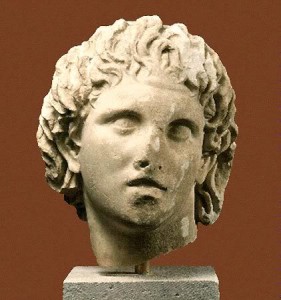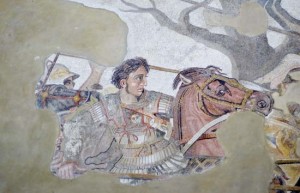Alexander the Great was born in Pella, in the city-state of Macedonia on July 20, 356 BC and died under mysterious circumstances in 323 BC in Babylon.
Alexander was the product of a dysfunctional family. His father was King Phillip of Macedonia. His mother was Olympias, daughter of the King of Epirus, a city-state in northern Greece. She was a beautiful eccentric woman who did odd things like worship snakes. She also sought power in her own right and was willing to use her son to get it. Olympias would tell Alexander that the great warrior Achilles who died fighting in the Trojan War was his ancestor and Alexander believed her.
His parents’ conflicts with each other placed a strain on Alexander and taxed his loyalties. Alexander was a mama’s boy yet he was also influenced by his father who was a brilliant warrior, scholar and statesman.
Alexander showed his genius at a very early age so Phillip hired the best teachers to tutor him. Leonidas, a relative of Olympias’, taught Alexander, who was a natural athlete, physical endurance. Lysimachus taught him reading and writing. The great Greek philosopher Aristotle taught Alexander a love for the Greek playwrights, law, medicine, natural and physical science, philosophy, and more importantly, how to think critically.
When Alexander was ten, Phillip took him to see war horses offered for sale. One particular horse was very wild and his owner wanted a lot of money for him. Phillip was furious that anyone would think he would want to buy such a horse but Alexander was confident that he could tame it.
Alexander noticed that the animal was afraid of his own shadow. He took the bridle and turned the horse to face the sun. He stroked it to calm its fears, mounted it and rode the horse down the length of the field. Phillip and the owner looked on nervously until Alexander and the horse returned.
“My boy,” Phillip said, “you must find a kingdom big enough for your ambitions. Macedonia is too small for you.” Alexander named the horse Bucephalus (“Ox head”) and Alexander rode him through most of his military campaigns. Bucephalus became one of Alexander’s best friends.
When Alexander was sixteen, Phillip appointed him as regent in his absence. During this time, Phillip and the Macedonian army fought one Greek city-state after the other. When Phillip’s attempts to defeat the rebellious cities in southern Thrace were not doing well, he summoned Alexander who successfully beat them. Phillip’s confidence in his son’s abilities grew so much that he sent Alexander back to Macedonia to continue to rule as regent.
But Alexander never stopped aiding his father in his campaign to conquer Greece. Phillip, emboldened by his victories, marched south toward his last opponent, Athens. Phillip extended an offer of peace to the city. The city rejected the offer. The two armies squared off. Although their armies were equal in strength, the Greeks had no important generals. Macedonia had Phillip and Alexander. Phillip divided his army into three sections with Alexander on his left and the Macedonian army on his right; in the center were his allies. The formation worked and Alexander and Phillip marched into Athens victorious.
Thus in 338 BC, Phillip achieved his dream of conquering Greece with the help of his eighteen-year-old son. But Phillip’s victory celebration wouldn’t last long. Shortly after his conquest of Greece, he married a Macedonian noble woman named Cleopatra. (Phillip had many wives in addition to Olympias.) This caused a rift in Alexander’s relationship with Phillip. When Cleopatra gave birth to a son, Caranus, Alexander felt even more isolated from his father.
Phillip’s next goal was to conquer Persia. He sent his generals ahead to plan this next invasion while he celebrated the wedding of Alexander’s sister. But on the second day of the wedding festivities, a Macedonian nobleman, Pausanias, murdered Phillip. Alexander inherited the throne as his father’s rightful heir but he first eliminated anyone who posed a threat to him including Caranus.
These events molded Alexander’s later life and character. They lay the ground work for his later leadership of Greece and his conquest of the known world. His greatest battles lay ahead.
To read more about Alexander:
Doherty, Paul. The Death of Alexander the Great. Carroll and Graf Publishers, NY, 2004.
Hammond, N. G. L. The Genius of Alexander the Great. University of North Carolina Press, Chapel Hill, 1997.
Lamb, Harold. Alexander of Macedon, The Journey to the World’s End. Doubleday and Company, Garden City, NY, 1946.
Macdonald, Fiona. The World in the time of Alexander the Great. Chelsea House Publishers, London, 2001. ,
Tsouras, Pete G. Alexander, Invincible King of Macedonia. Brassey’s, Inc., Dulles, VA, 2004
ART PROJECT
One of the few known images of Alexander the Great is his profile on a gold coin. Other images include statues, busts and mosaics. Do you think those images are correct? What do you think he really looked like? Use a search engine to see the existing images of him and draw a portrait of him.
For more help in drawing faces, here are links with tutorials on drawing faces:





